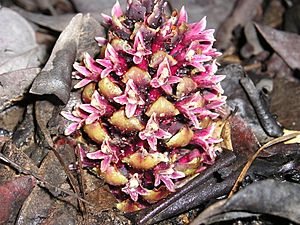California groundcone facts for kids
Quick facts for kids California groundcone |
|
|---|---|
 |
|
| Scientific classification | |
| Genus: |
Kopsiopsis
|
| Species: |
strobilacea
|
The California groundcone, also known by its scientific name Kopsiopsis strobilacea, is a very special kind of plant. It's a parasitic plant, which means it gets its food and nutrients by attaching itself to other plants. Think of it like a plant that "borrows" food from its neighbors!
This unique plant belongs to the Orobanchaceae family, which is a group of plants known for being parasites.
Contents
Where the California Groundcone Lives
The California groundcone is native to two states in the United States: California and southern Oregon. You can usually find it growing in wooded areas, especially where there are lots of trees. It also likes a type of shrubland called chaparral. Chaparral is a tough, dry area with many shrubs and small trees.
How This Plant Gets Its Food
The California groundcone is a parasite of specific trees and shrubs. It mostly targets manzanitas and madrones. These are common trees and shrubs found in California and Oregon.
How does it "borrow" food? The groundcone has special parts called haustoria. These are like tiny roots that grow into the host plant's roots. Once attached, the haustoria can tap into the host plant's system and take nutrients and water. This way, the groundcone doesn't need to make all its own food through photosynthesis like most plants.
What the California Groundcone Looks Like
You might not always see the California groundcone because much of it grows underground, attached to its host. But when it's ready to show itself, a visible part pops up above the ground.
This part is called an inflorescence. An inflorescence is a cluster of flowers on a stem. For the groundcone, this inflorescence can grow up to 18 cm (7.1 in) (about 7 inches) long. It often looks dark purplish, reddish, or brown.
If you look closely, you'll see pale-margined purple flowers peeking out from between overlapping bracts. Bracts are like small, leaf-like structures that protect the flowers. They are often different in color or shape from regular leaves.
Its Scientific Name and History
For a long time, the California groundcone was known by a different scientific name: Boschniakia strobilacea. However, scientists who study plants, called taxonomists, are always learning new things.
Thanks to modern research, especially using phylogenetics (which studies how living things are related through their genes), many taxonomists now believe this plant fits better in a different group, or genus, called Kopsiopsis. This change helps scientists understand the true family tree of plants.

